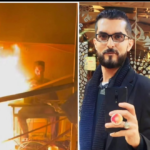Airstrike Hits Journalists’ Tent in Gaza: A Tragic Attack on Press Freedom
Date: April 6, 2025
Location: Khan Younis, Gaza
An Israeli airstrike on the night of April 6, 2025, has tragically targeted a journalists’ tent near the Nasser Medical Complex in Khan Younis, Gaza, resulting in the death of one journalist and leaving another in critical condition. The attack has drawn international condemnation and raised concerns over the safety of journalists working in conflict zones.
The airstrike struck the journalists’ tent, which was reportedly housing a group of media professionals covering the ongoing conflict in Gaza. The footage from the scene showed the tents engulfed in flames, with devastating consequences. According to witnesses, one journalist was trapped inside the burning tent and could not be rescued in time, leading to their death. The second journalist, identified as Hassan Aslih, has sustained severe injuries and is currently in critical condition at a local hospital.
The Targeted Journalists and Immediate Impact
The targeted tent was reportedly a hub for journalists who had been providing coverage of the humanitarian crisis in Gaza, as well as reporting on the broader political and military dynamics of the ongoing conflict. The journalists working in the region often face significant risks, including airstrikes, bombings, and other forms of violence, as they report on the impact of the conflict on civilian populations.
While details regarding the specific identity of the deceased journalist have not yet been fully confirmed, the incident has sparked widespread alarm within the international media community. Press freedom organizations have voiced concern over the increasing targeting of journalists in conflict zones and have called for greater protections for media professionals working in areas affected by war.
Hassan Aslih’s Condition and Response from Medical Teams
Hassan Aslih, the journalist who survived the attack but remains in critical condition, is being treated at Nasser Medical Complex, a facility that has been a focal point for medical care in the area. The complex, which is located near the site of the strike, is one of the primary hospitals providing emergency treatment to victims of the ongoing conflict. Doctors have described Aslih’s condition as dire, with multiple injuries sustained in the attack. Efforts are being made to stabilize his health, but his prognosis remains uncertain.
Aslih’s case highlights the perilous situation faced by journalists who are often caught in the crossfire of violent conflicts. The fact that the attack targeted a journalists’ tent specifically raises troubling questions about whether this was a deliberate targeting of the media or a tragic collateral effect of the military operations.
International Reactions and Calls for Accountability
The Israeli airstrike has provoked immediate reactions from international organizations and governments. Press freedom groups, such as Reporters Without Borders and the Committee to Protect Journalists, have condemned the attack, calling it an affront to the safety of journalists and a violation of international law, which protects journalists in conflict zones. These organizations have demanded a full investigation into the airstrike to determine whether the attack was intentional or a case of mistaken targeting.
The United Nations and various human rights groups have also issued statements calling for greater protection for journalists and media workers in Gaza and other conflict zones. They have emphasized the importance of preserving press freedom, particularly in regions where information is critical for informing the global community about the humanitarian impact of conflict.
The Broader Context: The Ongoing Conflict in Gaza
The airstrike on the journalists’ tent is a stark reminder of the dangerous environment that journalists face while working in conflict zones. Gaza has long been a flashpoint for violence, with journalists often risking their lives to provide independent reporting on the situation. The region has witnessed numerous casualties among journalists, with many being injured or killed while covering military operations, airstrikes, and protests.
The ongoing conflict between Israeli forces and militant groups in Gaza has resulted in significant loss of life and widespread destruction. Journalists in Gaza have played a crucial role in documenting the human toll of the conflict, often under extreme conditions. Despite the risks, many journalists continue to report on the situation, driven by a commitment to providing accurate and timely information to the public.
Conclusion: A Tragic Loss and a Call for Accountability
The death of a journalist and the critical injury of another in the Israeli airstrike near Nasser Medical Complex is a tragic reminder of the dangers faced by media professionals in conflict zones. As the world reacts to this incident, there are renewed calls for the protection of journalists and the need for accountability in the targeting of media personnel during armed conflicts. This attack underscores the importance of upholding international laws that protect the press and ensure the safety of those who risk their lives to report the truth.
Airstrike Hits Journalists’ Tent in Gaza: A Tragic Attack on Press Freedom.




